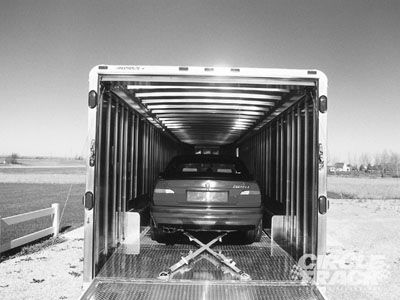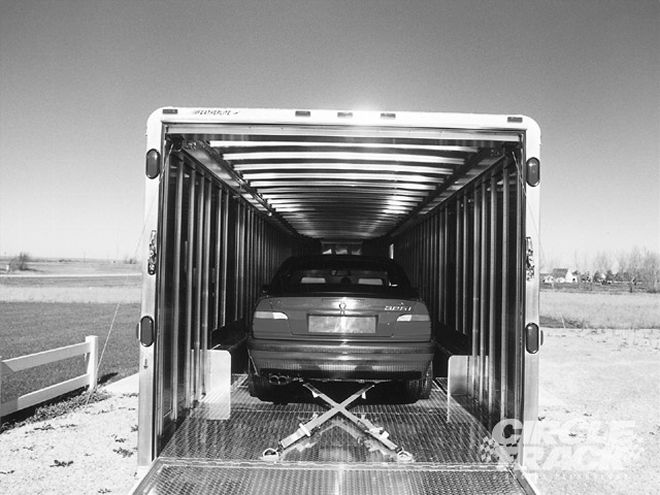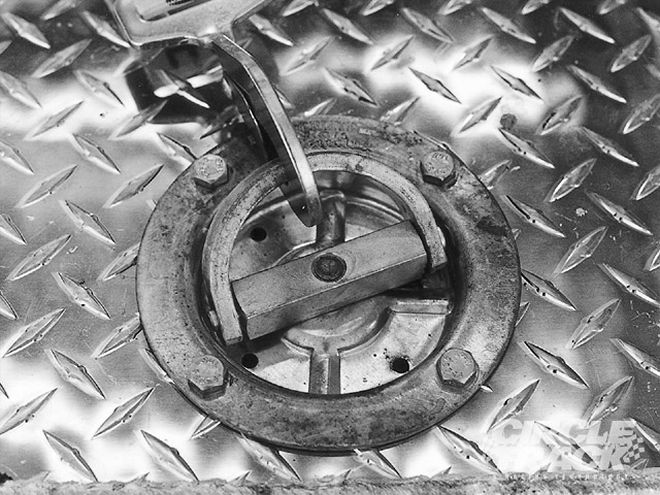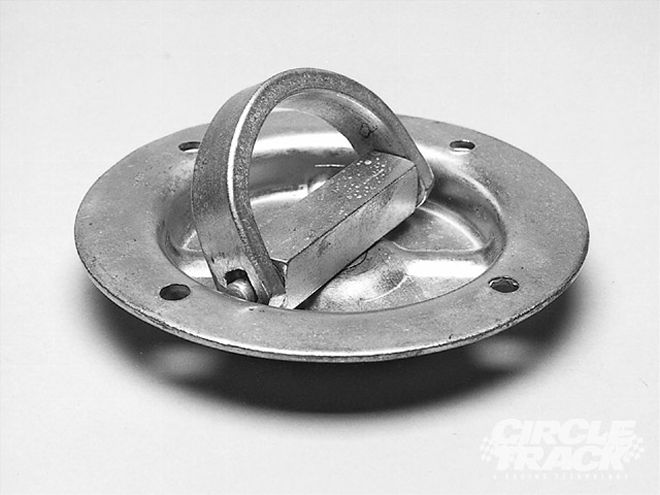
 A properly tied down vehicle in the rear. Note recessed rotating D-rings, which are firmly anchored.
A properly tied down vehicle in the rear. Note recessed rotating D-rings, which are firmly anchored.
Let's face it--most of the energy put into a race car has to do with making it go faster, and most of the thought about trailering that race car from track to track has to do with how comfortable and cool your trailer can be made. Does the trailer have enough tool space, a welder, a lounge? Perhaps this year you've added a refrigerator, a stereo, air conditioning, or other creature comforts.
But how much time should you devote toward ensuring you have an efficient and safe tie-down system for your race car, tool bins, and spare parts? If you are like most racers, the answer is "not much." Yet every year trailers jackknife, cars and tools are thrown about or off the trailer, unnecessary expenses are absorbed, and in some cases, disasters happen. Many of these cases occur because the race car and trailer were not properly tied down, and most can be avoided with just a little thought and effort.
According to Mike Galvin of Featherlite Trailers, his company performs tie-downs for only about 5 percent of the trailers it sells. Most racers are do-it-yourselfers and will install their own fasteners, tracks, and straps. To avoid a potential disaster, it is important for racers and crew members to know the basics of a tie-down system.
Safety First
There is probably no thought worse than hauling your precious race car to a race, encountering a driving situation that requires an emergency stop, and seeing your own race car pass you on the right--without a driver in it. Race cars and equipment do fall off trailers, and in just about every case, these accidents could have been avoided by practicing proper tie-down procedures.
"Most people don't consider that a trailered race car is a rolling dynamic load," says Virgil Brown, president of M & R Safety Systems. "Developing a tie-down system with the proper hardware and strapping method is crucial to maintaining control of the car and equipment when an emergency arises. It isn't often that emergency situations occur, so people sometimes neglect proper tie-down procedures. But when that situation arises--and it does for every racer--your tie-down system is your best friend."
Properly tying down a car and equipment starts with balancing your trailer for proper tongue weight (percentage of weight on tongue). That will be determined by the trailer type and your load. While different manufacturers have their own recommendations, a good rule of thumb is as follows: for a single or tandem axle trailer with a bumper pull, 10-15 percent tongue weight; for a fifth wheel or gooseneck, 15-25 percent. Of course, 18-wheelers are in a category of their own, and weight distribution, while important, is not as critical as with a small trailer, where the load is a much higher percentage of the overall weight (see sidebar "Guidelines for Proper Loading").
When a trailer slows down, the race car and equipment want to keep going. The race car is particularly vulnerable to dynamic movement because it is on wheels. That is when the straps and anchors of the tie-down system do their job. A proper tie-down system for a race car incorporates four tie-down points and straps. However, only two of the straps are usually called upon to handle the weight and security of the car at any one time.
"When a truck and trailer stop, the front straps of the tie-down system relax while the rear ones are in tension doing all the work," says Brown. "The opposite occurs during acceleration. In a jackknife situation, much of the load is lateral--again changing the load on the straps. Therefore, to properly calculate the working load of the straps, you must consider that only two straps are holding the car, not four. We take the weight of the car, say 3,000 pounds, and multiply it by 3.3 to arrive at a safe working load. Therefore, 3.3 times 3,000 equals 10,000 pounds. And if two straps are holding down the car, they must have the strength to hold more than 5,000 pounds each. That's why we use straps and anchors rated for 6,600 pounds on a 3,000 pound car."

All trailer and tie-down manufac-turers quickly point to the weak-link theory of tying down race cars and equipment; that is, the system is only as strong as the weakest link of each connection.
"Your straps may be rated at a certain strength, but if your D-rings or tracks only hold half that amount, that is the rating of the system link," says Paul Craig of Sooner Trailer Manufacturing. "Every component in a system is rated. But if a strap is rated at 5,000 pounds, the D-ring at 6,000 pounds, but the screws of the D-ring attachment 2,000 pounds, the rating of that tie-down strap link will be 2,000 pounds."
Straps, tracks, and D-rings all have ratings, which every installer and user should be aware of. That rating is also affected by the angle of the tie-down strap, which ideally should be in the 25-35 degree range. That provides both forward-and-aft, and to a lesser degree, up-and-down restraint. Also important are the tie-down points of the straps to the car.
"Tie-down points should be to the axle or some fixed point below the suspension," says Brown.
Another system of tying down a car is with over-the-wheel straps. This system can be very easy to use, but it is important that the straps be used correctly. A single strap holding down the wheel is not a good method--wheels can lose air, and when that happens the connection can become very loose, even to the point of the strap falling off the tire. Remember that part about the car falling off the trailer and passing you?
Much better are the use of tire bonnets--straps that hold the tire down along the top and sides. These bonnets combine the simplicity of single-point attachment hooks with the security of both front-and-rear and lateral restraints.
Most Common Mistake
All manufacturers of trailers and tie-down systems have some good stories about tie-down mishaps, but a common theme arose as to how many of the accidents occurred. That theme is of a D-ring pulling out from its screw anchors.
"The quality of a tie-down system often comes down to the quality of the installation, and the number-one mistake we find is when people put small, little lag screws into plywood when installing D-rings or some other attachment. This is done all the time, especially in the floorboards, often of old and weakened plywood," says Galvin of Featherlite.
For those of us who have seen an overmuscled crew member crank down on a strap ratchet, we can imagine a D-ring being yanked right out of its mounting.
Attachment points, such as D-rings and railing systems, should be secured by methods that don't compromise the load ratings of these attachments. This usually means using through-bolts, metal backing plates, and cross-members welded in underneath the floorboards to chassis points. This will ensure that the attachment and its hardware will never be that weak link in the system.
Versatility
Holding down cars and equipment can be a quick, easy, and secure operation. However, it can also be cumbersome and awkward. Once the necessary load and design criteria have been established for your trailer, the easier your system will be to use and the more likely proper tie-down procedures will be followed by the crew.
Like everything else in racing, the quality of tie-down equipment varies. D-rings, for example, are of different strength ratings, can be flush- or recess-mounted, and can be fixed or rotating. Straps can have simple hook ends or safety keepers. Make sure they don't fall off a connection point. Straps themselves can greatly range in their breaking strength.
 Here are three different D-ring designs, each with separate loading capabilities: flush-mount (A), recessed-mount (B), and rotating recessed-mount (C).
Here are three different D-ring designs, each with separate loading capabilities: flush-mount (A), recessed-mount (B), and rotating recessed-mount (C).
Perhaps the most versatile of components available are the different track systems now being offered by trailer and equipment manufacturers. The commonly used steel E-tracks have been used for years as a generic slotted-track system, which holds down different fasteners and connecting points. Their drawback has been that they are hard to flush-mount--although they can be surface-mounted virtually anywhere in a trailer--and have limited attachments.
New on the market are some slick aluminum-track systems, such as the ones offered by Mac's Custom Tie-Downs. This system offers a variety of surface or recessed-mount tracks and single-point connections. More importantly, they offer a wide variety of rings and attachments that provide a completely versatile system with high-strength connections.
Trailer manufacturers are now offering track systems such as these installed in floorboards, walls, and even ceiling and roof structures. Because of the aluminum construction, the tracks last much better in exterior applications.
Whatever tie-down system ends up on your trailer, it is worth your while to make sure it is up to speed in terms of safety, function, and versatility. As with everything in racing, progress has been made in the quality and effectiveness of tie-down systems. Spend a little time to ensure you have a trailer that will keep your race car and equipment where you want it.
Guidelines for proper loading:
* Know your trailer's gross weight, along with the weight fully loaded. Make sure you are within the vehicle's and hitch's recommended maximum.
* Load your trailer well below the maximum for the first two uses with a new rig, or while you are learning.
* Keep track of the weights of the individual items as you load them. When in doubt, guess high.
* Adjust the load so you have the recommended hitch-weight percentages.
* Attach the trailer to the tow vehicle, and note how much the rear end drops. If it looks excessive, check the tow vehicle's load capabilities again.
* When in doubt, call the trailer manufacturer.